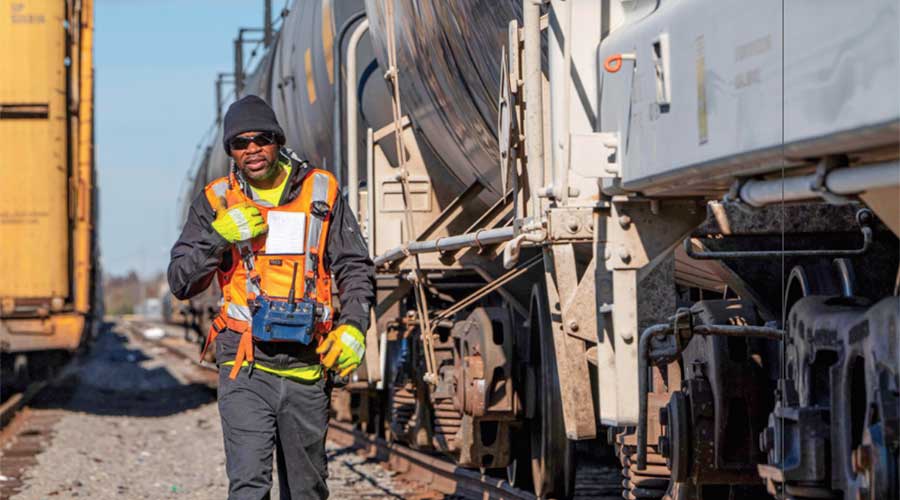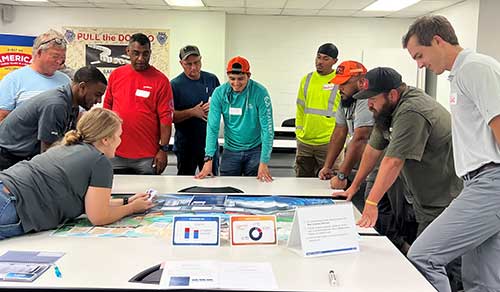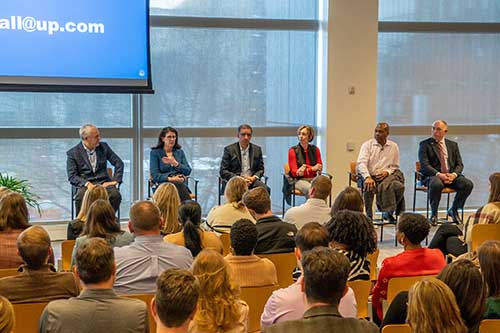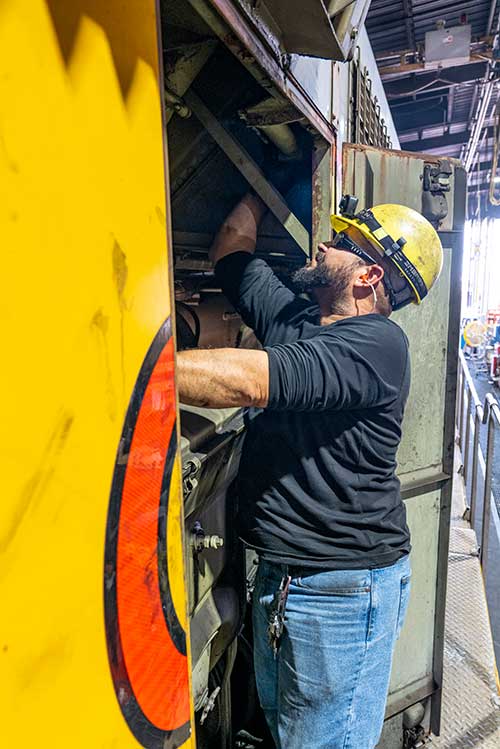Union Pacific drives down decision-making to pump up service performance

By Jeff Stagl, Managing Editor
It’s been quite a whirlwind for Union Pacific Railroad over the past year-plus. There have been a few highs, but many lows.
In December 2022, the Surface Transportation Board held a hearing to examine why UP placed embargoes — or short-term limits — on shipments to try and clear up network congestion, a tactic the STB claimed the railroad used more than other Class Is. UP’s embargoes shot up from five in 2017 to more than 1,000 in 2022, and the STB received numerous complaints from shippers about associated supply-chain problems.
Shippers, regulators and other UP stakeholders had other major gripes with the Class I about its lagging financial performance and poor state of service for a prolonged period. So much so, a major UP shareholder early last year demanded the company replace President and CEO Lance Fritz.
Leaders of Soroban Capital Partners LP — a hedge fund that holds a $1.6 billion stake in the railroad — sent a letter to UP’s board stressing that the Class I ranked the worst among the largest railroads in safety, cost management, volume, revenue and earnings growth, and total shareholder return.
“These are highly underwhelming results despite UP having the premier railroad franchise in North America,” wrote Soroban Capital Managing Partner Eric Mandelblatt.
Members of UP’s board ultimately agreed, and in March 2023 reached an agreement with Fritz to step down as chairman, president and CEO once a new leader was installed. The board later settled on Jim Vena as the next leader.
A more than 40-year rail industry veteran, Vena previously was UP’s chief operating officer from 2019 to 2020 and a senior adviser to Fritz in 2021. Prior to that, Vena served CN for more than four decades in various roles, including executive vice president and COO. A longtime railroader, he was a brakeman, conductor, locomotive engineer, trainmaster and superintendent prior to becoming an executive.
Soroban Capital backed Vena, 65, as a prime CEO candidate, as did other rail industry stakeholders and observers. In a July 2023 note to clients, Susquehanna International Group LLP analyst Bascome Majors hailed the choice.
“We believe Jim Vena was the best candidate available to get the trains running consistently on time at Union Pacific, and see a potential virtuous cycle ahead of improving service levels, volume growth and profit growth,” Majors wrote.
Fritz officially stepped down Aug. 11, 2023, and Vena became UP’s CEO three days later. Before he accepted the position, Vena said he mulled the choice of climbing Asia’s K2 — the world’s second-highest mountain — as a retired industry veteran or returning to the rail exec world. He opted to climb a big mountain of another sort by rejoining UP.
The mission: Make UP great again
When he departed the railroad as COO in 2021, he felt good about how UP was performing, Vena says. He was recruited to help the Class I transition to a precision scheduled railroading operating model.
But he found it discouraging that soon afterward, the railroad’s performance deteriorated. That prompted his decision to lead a turnaround at UP.
“This is a challenge. Almost everything in life is a challenge,” says Vena.
He touts UP as a great franchise built over the past 161 years that has a great customer base, network and access. Now, it’s time to build on the company’s rich history and legacy.
“I want to be a good custodian of the railroad for the next generation,” says Vena. “So how do we write the next chapter?”
He’s spent the past four-plus months trying to answer that question. Vena believes he’s set a clear vision for UP: become the best performer in safety and service and reach operational excellence to spur growth.
The railroad can attain the best safety record in the industry, build a reputation for providing superior service, grow consistently and achieve optimal efficiency if all UPers are more in lockstep, Vena believes.
To reach that in-sync stage, the railroad needs to distance itself from being a top-down, command-and-control organization and become the reverse: a down-top company with much less bureaucracy that encourages decision-making at the ground level to reduce layers, expand spans of control and speed actions.
“I want decisions to be made at the local level — and the lower the level, the better,” says Vena.
Such a cultural reset can create a more solid foundation for how UPers approach work while the railroad continues to face a tough economic landscape dotted with high inflation, lower volume and rising costs.
Implementing such monumental change is extremely hard, but UP has a high number of “bright, resilient and honorable people” who can help pull it off, Vena believes. Although the transformation will require sacrifices — such as recent management cuts — he’s convinced UP will become a leaner, faster-acting and more resilient company as a result.
Roll with the ebbs, flows
Since there wasn’t a one-size-fits-all approach suited for changing every aspect of the organization, each department late last year reviewed how it performed work and how to reprioritize it with a better focus on employees and resources. Department heads factored in anticipated attrition and created a buffer of resources to handle the expected ebbs and flows and cyclical nature of the railroad’s business.
Some departments required only small tweaks while others instituted significant changes. As a result, the number of management jobs was reduced by about 5%. Some employees were asked to contribute to the railroad in different ways or were provided the opportunity to apply for craft positions.
Ultimately, most workers are highly vested in UP and want to be part of what the company is trying to accomplish, says Vena.
“I see the pride employees have when I’m out in the field, how they wear a hat or shirt with the UP logo,” he says.
The people in the field are at the crux of what it takes to run the railroad: If everyone at UP’s Omaha, Nebraska, headquarters took off for 24 to 48 hours, the railroad would continue to operate just fine, Vena stresses.
Since people in the field predominantly will execute change, sometimes their decisions will turn out to be errors. That’s to be expected and it’s OK to make mistakes because vast improvements sometimes require the courage to make hard decisions, Vena says.
“No one is perfect — mistakes will be made,” he says. “I have made mistakes.”
All in it to win it
To help ensure each of UP’s 30,000 employees gains a better understanding of their role in the company achieving the objectives — and what those goals are — the railroad is conducting a new training program that targets the entire workforce. Called “How We Win Together,” the program is conducted in small groups and takes a couple of hours to complete.
The interactive program is played like a game using a hand-drawn “map” on a table. Employees talk about the objectives, implications, challenges and potential outcomes of simulated train movements on the map, which helps explain organizational goals.
The program helps get employees rooted in the pride and history of UP, and educates them about the new mission, says Beth Whited, who was promoted from EVP of sustainability and strategy and chief human resources officer to president when Vena became CEO. A person laying rail in Arizona wouldn’t necessarily know how the company makes money, Whited adds.

“The program helps to explain the strategy and the whys, and to build knowledge in the field,” she says. “It shows what the barriers are and helps to build a collective mindset.”
The program is very low-tech by design — it isn’t like a school film during which “a lot of students zone out,” says Whited.
So far, about 3,000 employees have completed the How We Win Together program and training will continue throughout 2024.
Another way employees can learn more about the company’s vision, strategy and objectives: a quarterly town hall meeting. The most recent one was held Dec. 19.
The meetings enable Vena and senior executives to provide details about organizational developments and field employees’ questions. The questions are not orchestrated or screened in advance, says Vena.
“I get them in the order they come in,” he says.
He can’t necessarily answer them all — there might be a question about whether restrooms will be upgraded at a certain yard — but he tries.

A high-energy person who tends to light up a room, Vena helps invigorate the town hall meetings, says Whited. The get-togethers help satisfy employees’ need for accurate and up-to-date information about the company, she adds.
“We are trying to be super transparent. We want to make work fun and fulfilling,” says Whited. “How someone measures and evaluates a workday is different, so everyone’s takeaway is different.”
A safer solution
Yet when it comes to improving safety — another top company goal — everyone needs to be on the same page.
To that end, UP instituted a new safety policy on Jan. 1. The policy targets potentially dangerous actions that occur more frequently and have the biggest impacts on the railroad, says UP EVP of Operations Eric Gehringer. It primarily focuses on six actions, such as protecting shoves and maintaining a proper and safe space between rail cars.
“Sometimes wind can move cars,” says Gehringer.
Policy enforcement involves software programs that communicate expectations, document actions, provide coaching and issue compliance reports.
UP also aims to improve safety — as well as boost productivity and efficiency — by conducting virtual engineer ride-alongs. Cameras in locomotive cabs are used by supervisors in office locations to provide live training sessions.
“It helps provide immediate feedback to engineers,” says EVP and Chief Information Officer Rahul Jalali, adding that the ride-alongs also help with developing and sharing best practices.
Technologies will be counted on, as well, to help boost safety and improve operations. Among them: 4,000 wayside detectors that provide 20 million data points each day, such as bearing temperatures; and autonomous track inspection systems on both locomotives and cars that can detect many deviations.
“Then we can take actions to stay well ahead of any failure,” says Gehringer.
UP also is working with dispatchers to digitize more of their duties/responsibilities. And more efforts are underway to digitize other areas, says Jalali.
For example, in the premium/intermodal sector of UP’s business, precision gate technology was installed at all major ramps as of November 2023. The gate system reduces the time trucks wait to get in or out of ramps — in some instances from 15 or several minutes to one minute or 30 seconds, says Jalali.
Truck drivers also can use the UPGo application on their smartphones to receive specific driving instructions and better navigate a large intermodal terminal.
“Some ramps have 6,000 parking spaces, so it’s like finding a needle in a haystack,” says Gehringer.
“I want to be a good custodian of the railroad for the next generation. So how do we write the next chapter?”
— Jim Vena, CEO
Invested in intermodal
In terms of UP’s business growth strategy, intermodal remains a key component. That’s why the railroad continues to invest aggressively in the sector, says EVP of Marketing and Sales Kenny Rocker.
The Class I is adding lanes to its Lance M. Fritz Inland Empire Intermodal Terminal in Southern California and trying to better exploit the location of some key facilities, such as the Twin Cities terminal in Minneapolis. UP plans to add more than 1 million units in lift capability to its terminal ramps over the next few years, with a significant portion of growth anticipated in the Los Angeles basin.
“It’s all about opening new markets,” says EVP and Chief Financial Officer Jennifer Hamann.
Moreover, UP plans to open a new international intermodal terminal in Phoenix in the first quarter to connect ocean ports and points in the Southwest. The terminal will be established in the railroad’s downtown rail yard.
“We didn’t have a footprint there before,” says Rocker.
In addition, the Class I is trying to establish or enhance more joint intermodal services with other Class Is and partners. Last year, UP launched an on-dock service with the Port of Houston; helped introduce the new Falcon Premium Mexico-U.S.-Canada service with CN and Grupo Mexico Transportes; removed a full day of transit time for its Eagle Premium service into Mexico with Ferromex; and unveiled a new domestic intermodal service with CSX, Norfolk Southern Railway and Florida East Coast Railway to connect Mexico to Florida, North Carolina and other key southeast U.S. markets.
Partnerships are a good way to tap deeper into emerging markets, such as renewable diesel or export petrochemicals, says Rocker. Acting as one railroad for customers helps take more trucks off roads.
“There are opportunities across the board — there is so much truck traffic out there,” says Rocker.
About 40% of UP’s business originates or terminates off of its network, so partnerships are vital, Hamann adds.
Be better by any measure
But the Class I likely won’t win more business unless it finds more ways to prove its worth to shippers. To that end, the railroad plans to unveil a new service performance index in the first quarter. Customers have different needs — such as unit-train or carload shippers — and the index is designed to better measure performance against their varying demand forecasts and capacity needs.
“We can take a step back to look at what was sold to a customer,” says Rocker.
It’s paramount that UP provides shippers the service that was promised and better communicates how it can help customers “win in the marketplace,” says Vena.

“Customers can look at service differently. For some it’s the transit time that’s important, and for others it’s consistency or that their product is moved in an efficient manner,” he says. “We need to perform to any way service is measured.”
There’s a sense of urgency now to act more decisively and to try a new approach to doing business, says Hamann. When the organization was too complex and procedural, decision-making was slow.
“Now instead of seven or eight people in a room, there are two or three. Then it’s easier to come to a decision,” says Rocker.
More poised to pounce
UP is far better off now to grow and improve in 2024 no matter the economy’s health, Rocker believes.
Third-quarter 2023 data showed UP was performing better operationally than in the second quarter. On a quarter-over-quarter basis, freight-car velocity rose 6% to 215 miles per car daily, average terminal dwell time dropped 3% to 22.6 hours and locomotive productivity improved 11% to 140 gross ton-miles per horsepower per day. And senior executives expected similar promising results in last year’s fourth quarter.
“I’d rather be in this position with better service and question marks about the economy than have a great economy and not be able to execute on it,” Rocker says. “You can’t take some risks then or make fast decisions.”
Hamann senses a big difference in UP’s potential going from 2023 to 2024 than from 2022 to 2023.
“We don’t know what the macro-economy will look like, but we have better momentum now,” she says.
The keys in 2024 will be to keep focusing on service, safety and getting the message out — to employees, shippers and other stakeholders — about how the railroad expects to grow.
“We have to communicate the key points,” Vena says.
For Whited, each employee needs to understand how they perform an important function that helps the railroad operate as it should.
“We want to see it all click in 2024,” she says.
Email questions or comments to jeff.stagl@tradepress.com.
No comments:
Post a Comment